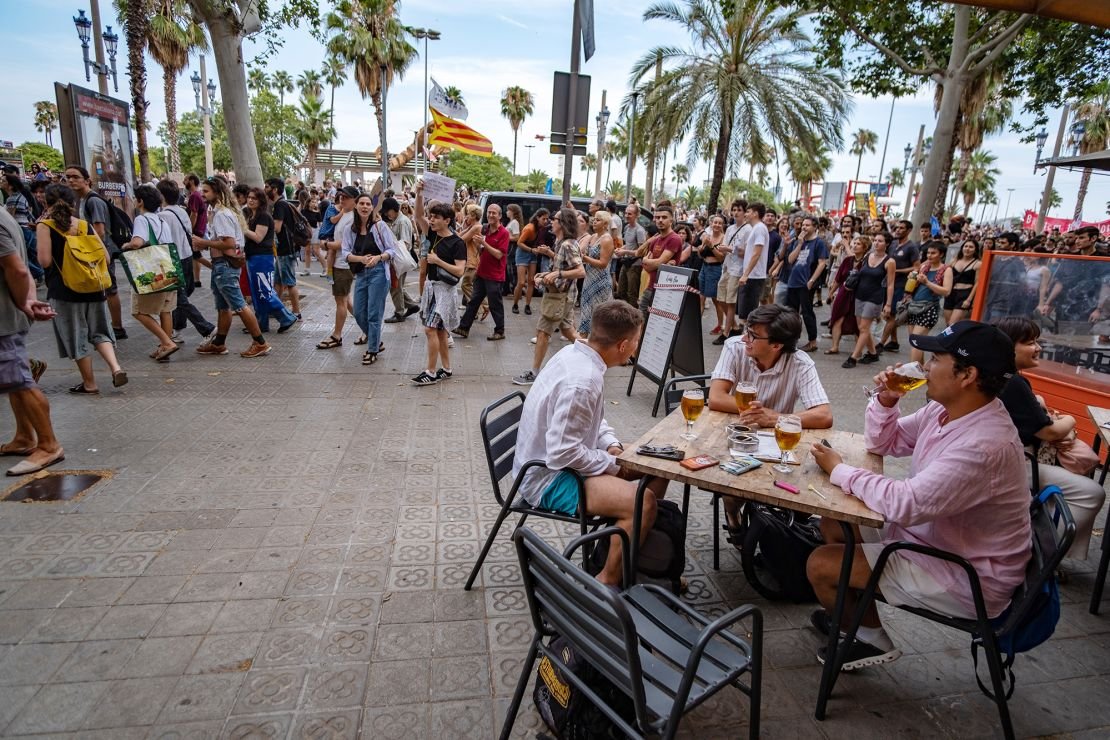After years of COVID-19 lockdowns, travel restrictions, and economic downturns, Barcelona, like many global cities, is experiencing a resurgence in tourism. With its iconic architecture, rich cultural history, Mediterranean beaches, and vibrant atmosphere, Barcelona is a city that has always drawn visitors from across the globe. The lifting of travel restrictions has led to a rapid rebound in tourism, but the surge in visitors has also brought new challenges that the city must address.
While this renewed influx of tourists signals a positive recovery for local businesses and the economy, it has also sparked a heated debate about the future of tourism in Barcelona. As the number of tourists steadily increases, concerns about overcrowding, the loss of local identity, and the environmental impact have escalated. Barcelona, once seen as the ideal tourist destination, now faces a major dilemma: how can it balance the benefits of tourism with the challenges it presents?
In this blog post, we will explore Barcelona’s tourism recovery, the challenges that the city now faces, and the steps it must take to ensure that it remains a vibrant and sustainable destination for both locals and visitors alike.
The Resurgence of Tourism in Barcelona
Before the COVID-19 pandemic, tourism was one of the primary drivers of Barcelona’s economy. In 2019 alone, the city welcomed more than 30 million visitors, contributing billions of euros to the local economy. Visitors flocked to iconic landmarks like the Sagrada Familia, Park Güell, and the Gothic Quarter, while also enjoying the city’s vibrant nightlife, world-class dining, and Mediterranean beaches.
However, the pandemic brought tourism to a grinding halt. Airports were closed, hotels were empty, and businesses reliant on tourists faced unprecedented losses. Barcelona’s economy, deeply intertwined with tourism, suffered dramatically. The city faced an uncertain future, with many worrying that it would take years to recover from the financial toll.
Fast forward to 2023, and the scene has changed dramatically. With travel restrictions lifted, the world’s desire to explore has reignited, and Barcelona is once again a prime destination. According to recent reports, tourist numbers have rebounded to pre-pandemic levels, with some estimates predicting even higher growth in the coming years. The return of international flights, the revival of cruise tourism, and the resurgence of cultural events and festivals have all contributed to Barcelona’s tourism boom.
While this recovery has brought much-needed economic relief, the city’s tourism sector is once again facing the familiar question: Can it handle the crowds?
The Crowding Crisis: Too Much of a Good Thing?
While the return of tourism is welcomed by many, it also brings with it significant challenges that the city is struggling to manage. As the number of visitors increases, so too does the strain on the city’s infrastructure, environment, and local residents. Overcrowding is becoming one of the most pressing issues for Barcelona, and it’s not just a problem for the summer months — it’s an issue that is now affecting the city year-round.
1. Overcrowded Landmarks and Public Spaces
One of the most immediate effects of the tourism surge is the overcrowding of Barcelona’s famous landmarks. The Sagrada Familia, perhaps the most recognizable symbol of the city, regularly sees long lines stretching down the streets as tourists eagerly await their turn to visit. The same can be said for other popular sites such as Park Güell, the Picasso Museum, and La Rambla.
During peak tourist season, the influx of visitors often leads to bottlenecks and congestion, making it difficult for both locals and tourists to enjoy these spaces. While some may argue that this is the price of fame, the reality is that overcrowding detracts from the very essence of what makes these landmarks special. Visitors come to see Barcelona’s beauty and historical significance, but they often leave feeling overwhelmed by the sheer number of people around them.
2. Environmental Impact: Straining Resources and Sustainability
With the increase in tourist numbers, the environmental impact of mass tourism has become more pronounced. Barcelona, like many other popular tourist destinations, is struggling to cope with the pressures of maintaining its infrastructure and natural resources in the face of this surge. Public transportation systems are overcrowded, and local water and energy supplies are stretched thin.
One of the most significant environmental concerns is waste management. With the increase in tourists comes a rise in waste production, including plastic waste, food packaging, and litter. Barcelona’s beaches, once known for their beauty and cleanliness, are often littered with trash during the peak tourist season. The city’s environmental resources are under pressure, and there are concerns about whether Barcelona’s infrastructure can keep up with the demands placed on it.
3. Housing Crisis: Tourism’s Role in Rising Rent Prices
Perhaps one of the most pressing issues faced by local residents is the housing crisis exacerbated by tourism. The demand for short-term rental properties, such as those offered by platforms like Airbnb, has led to a sharp increase in rental prices across the city. As more properties are converted into tourist accommodations, there is less housing available for local residents, which drives up prices and reduces the supply of affordable homes.
This has led to frustration among Barcelona’s residents, many of whom feel that the city is being overrun by tourists at the expense of its local communities. The growing number of short-term rentals has been linked to the displacement of residents from popular neighborhoods, particularly in areas like the Gothic Quarter and El Born. Many locals feel that the city’s housing market has become increasingly unaffordable and is being driven by the demands of tourism rather than the needs of its residents.
The Loss of Local Identity
Barcelona’s rapid tourism growth has also sparked concerns about the erosion of its local culture and identity. As the city becomes more focused on catering to tourists, there is a fear that its unique charm and authenticity are being compromised. Once-traditional neighborhoods are being overtaken by tourist shops, chain restaurants, and luxury developments, and there is a growing sense that the needs of local residents are being sidelined in favor of satisfying visitors.
The rise of mass tourism has also led to the commodification of local culture. Catalan traditions, language, and customs are often reduced to mere attractions for tourists, stripped of their deeper meaning. The commercialization of Barcelona’s cultural heritage has led some locals to question whether the city is losing its soul in the pursuit of tourism revenue.
Additionally, the constant influx of tourists has created a sense of alienation among locals. As more neighborhoods become tourist hotspots, residents find themselves living in areas that no longer feel like home. The authentic, local atmosphere that once characterized Barcelona is increasingly being replaced by a transient, tourist-oriented environment.
Efforts to Address the Tourism Problem
Recognizing the strain that tourism is placing on the city, local officials and organizations are taking steps to address the challenges associated with mass tourism. The question remains, however: Can Barcelona strike a balance between maintaining its tourism industry while preserving the quality of life for residents and protecting the city’s cultural identity?
1. Tourism Management and Regulation
In recent years, the city has introduced measures to manage tourism more effectively. For example, Barcelona has implemented stricter regulations on short-term rentals, limiting the number of licenses granted for platforms like Airbnb. This is an effort to curb the rise in rental prices and prevent the displacement of local residents. The city has also introduced policies to control the number of tourists allowed into certain sites and areas, particularly during peak seasons.
Barcelona has also made efforts to encourage tourists to explore lesser-known neighborhoods and attractions, thereby spreading out the economic benefits of tourism more evenly across the city. By promoting areas outside of the central tourist districts, the city hopes to reduce congestion in popular areas while providing a more authentic and less crowded experience for visitors.
2. Sustainable Tourism Practices
Sustainability has become a key focus for Barcelona’s tourism strategy. The city is working to develop a model of “sustainable tourism” that emphasizes eco-friendly practices, responsible consumption, and minimizing the environmental impact of tourism. This includes encouraging visitors to use public transportation, supporting local businesses, and promoting sustainable practices in hotels, restaurants, and attractions.
Barcelona has also invested in infrastructure improvements to ensure that its natural resources are protected. For example, the city has taken steps to address waste management by increasing recycling efforts and implementing waste reduction initiatives in tourist-heavy areas. Moreover, the city is exploring ways to protect its beaches and green spaces from the damaging effects of mass tourism.
3. Preserving Local Identity
Efforts to preserve local culture and identity in the face of growing tourism are also a priority. Initiatives are underway to protect traditional neighborhoods from overdevelopment and gentrification. By implementing zoning laws and restrictions on new tourist accommodations, the city hopes to safeguard the character of its residential areas.
In addition, there is a concerted effort to promote local Catalan culture, traditions, and language. Barcelona has introduced programs that encourage tourists to engage with the city’s heritage in a meaningful way, such as cultural tours led by local guides and experiences that allow visitors to interact with local artisans and community members. The goal is to ensure that tourism does not simply exploit local culture, but rather celebrates and preserves it.
Conclusion: Finding the Balance Between Tourism and Sustainability
Barcelona’s tourism revival is undoubtedly a success story in many ways, especially given the challenges of the COVID-19 pandemic. However, the city now faces a crucial question: How can it manage the growing demand for tourism while protecting its environment, cultural heritage, and local communities?
The surge in tourism has revealed both the benefits and the drawbacks of the industry. While tourism is essential to Barcelona’s economy, it must be managed carefully to avoid damaging the very qualities that make the city so special. Through smart policies, sustainable practices, and a commitment to preserving local identity, Barcelona can navigate these challenges and continue to be a global destination without compromising its future.


